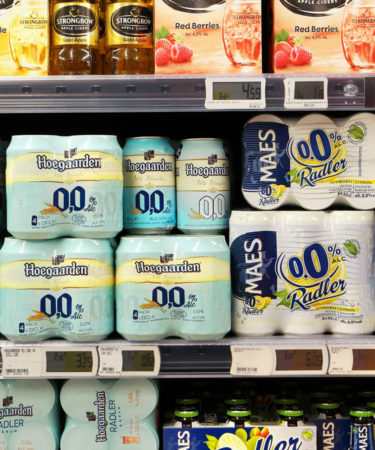Let’s get this out of the way: Dry January is bad for beer. It eats into restaurant traffic and bar sales, and many small businesses suffer or even close.
And yet here we are in the throes of Drynuary, drinking as per our usual schedules, but adding something else to this mix: craft near beer.
While the category’s inroads into beer sales as a whole are negligible — by last IRI count, 0.37 percent of total beer dollar sales as of December 2019 — it’s impossible to ignore the inching rise of non-alcoholic and low-alcohol, low-calorie beers.
I find myself trying and buying non-alcoholic beers out in the wild on days that I’m drinking, bringing a big beer offering to a party, or looking for something to sip when I’m not feeling up to a buzz. I know I’m not the only one.
Alcohol chain retailer BevMo! has doubled its non-alcoholic beer brand offerings since February, Amy Gutierrez, BevMo category manager for beer, told Good Beer Hunting in December 2019. “It’s not just St. Pauli Girl or Beck’s,” she said. “These are truly crafted beers with new flavors and I think that’s really what [customers] love. They are purchasers who don’t just buy one six-pack or one 12-pack. They buy entire cases.”
Here at the VinePair HQ, we recently tasted and ranked NA beers and our panel agreed that five we tried are at least decent, and at best delicious. This is a short but significant list.
Beyond the brands mentioned here, such as Athletic Brewing Co., Brooklyn Brewery, and BrewDog, brands with the sole intention of crafting non-alcoholic beverages are opening across the U.S., such as WellBeing Brewing and Surreal Brewing. They are not only here for alcoholics, pregnant women, and teetotalers. They are here for beer drinkers like you and me.
I predict the market for tasty near beers will slightly rise — certainly nowhere near the level of hard seltzer or light lager, not even close — but you’ll be seeing NA options on your beer bars’ draft lists soon. This not only offers respite to your body, but can help beer-centric bars and restaurants (and maybe even traditional, booze-loving breweries) sell more drinks durning the January dry spell.
Is Light, Bright Craft Eclipsing Winter Warmers?
In the past week, several “light” craft beers and hard seltzers have hit the market: Deschutes debuted Wowza Lo-Cal Hazy Pale Ale. Maui Brewing Co. released Mosaic Lite Session IPA. Bell’s Brewery launched Light Hearted, a 3.7 percent ABV, 110-calorie version of its dominating Two Hearted Ale in 19.2-ounce stovepipe cans. And there are many more.
These add to the long list of low-calorie, low-alcohol light craft beers on the market, and the dozens of craft hard seltzer brands that continue to roll out across the U.S. All hover around 100 calories and between 4 and 5 percent ABV.
As Paste reports, this looks a lot like the session IPA trend. The difference is calories. Session beers were (and are) marketed as having all the flavor of craft ales with less alcohol, so one could theoretically drink them all day without sacrificing deliciousness. Still, the concept of balancing flavor with sessionability has gone out the window for straight-up calorie counts. This is written on the light craft labels themselves, many of which prioritize phrases like “99 Calories” or “Low Cal. High Haze.” on the package more than the brewery or beer name itself. (Those were Mother’s Brewing Courage Partner IPA, and Oskar Blues One-y IPA, respectively.)
Although it may seem like all we can talk about are lower-alcohol, lower-calorie beers, this doesn’t reflect what American beer consumers are buying. According to IRI, volume sales of higher-alcohol craft beers 7 percent ABV and up grew 10.5 percent in the first half of 2019. “Sessionable,” low-alcohol brands didn’t grow at all.
I’ll embrace the change, and continue intermittently sipping beers with low alcohol and calorie counts — I’m not getting any younger or thinner, either — but I’ll have my cake stout and drink it, too.
This story is a part of VP Pro, our free platform and newsletter for drinks industry professionals, covering wine, beer, liquor, and beyond. Sign up for VP Pro now!
